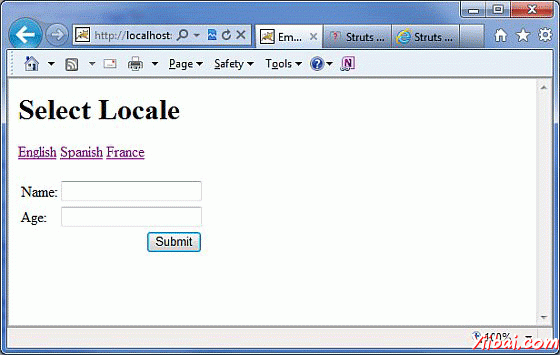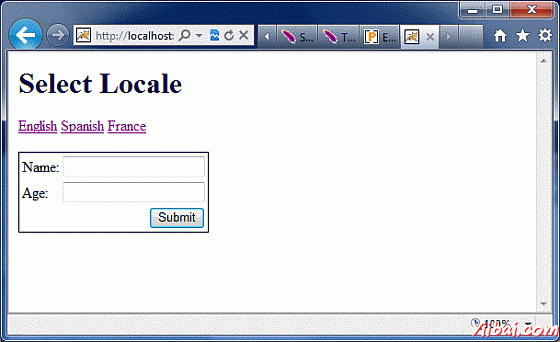Struts2 主題和模板
實際本章教程開始之前,讓我們看看由http://struts.apache.org給出的幾個定義:
Term
描述
tag
A small piece of code executed from within JSP, FreeMarker, or Velocity.
template
A bit of code, usually written in FreeMarker, that can be rendered by certain tags (HTML tags).
theme
A collection of templates packaged together to provide common functionality.
我也建議去通過Struts2本土化章節,因爲我們將採取同樣的例子,再次執行我們的練習。
當使用Struts 2 標籤如<s:submit...>,<s:textfield...>等在網頁中,Struts 2框架生成HTML代碼與預先設定的樣式和佈局。 Struts 2自帶內置的主題有三個:
Theme
描述
simple theme
A minimal theme with no "bells and whistles". For example, the textfield tag renders the HTML tag without a label, validation, error reporting, or any other formatting or functionality.
xhtml theme
This is the default theme used by Struts 2 and provides all the basics that the simple theme provides and adds several features like standard two-column table layout for the HTML, Labels for each of the HTML, Validation and error reporting etc.
css_xhtml theme
This theme provides all the basics that the simple theme provides and adds several features like standard two-column CSS-based layout, using
正如上面所提到的,如果不指定一個主題,然後Struts2中會使用默認的XHTML主題。例如Struts 2中選擇標籤:
<s:textfield name="name" label="Name" />
生成HTML標記:
這裏empinfo struts.xml文件中定義動作名稱。
選擇主題:
可以指定主題Struts 2每一個標籤的基礎上或指定的主題Struts 2使用,可以使用下列方法之一:
主題屬性的具體標籤
主題屬性標籤的周邊表單標籤
頁面範圍的屬性,名爲「主題」
請求範圍屬性名爲「主題」
會話作用域屬性命名爲「主題」
應用程序作用域的屬性命名爲「主題」
在struts.properties struts.ui.theme屬性(默認爲XHTML)
以下語法指定他們在標籤級別,如果願意爲不同的標籤使用不同的主題:
<s:textfield name="name" label="Name" theme="xhtml"/>
因爲它不是非常實用,每個標籤的基礎上使用主題,所以乾脆我們可以指定規則struts.properties文件中使用以下標籤:
# Standard UI theme struts.ui.theme=xhtml # Directory where theme template resides struts.ui.templateDir=template # Sets the default template type. Either ftl, vm, or jsp struts.ui.templateSuffix=ftl
以下的結果是,我們拿起從本地化章節裏我們使用默認設置struts.ui.theme= XHTML的struts-default.properties文件中,默認情況下,在 struts2-core.xy.z.jar文件,這是由主題。

主題如何工作的?
對於一個給定的主題,每一個struts標籤有關聯的模板,如:s:textfield -> text.ftl 和 s:password -> password.ftl等,這些模板文件來壓縮struts2-core.xy.z.jar文件。這些模板文件保持一個預先定義的HTML佈局爲每個標籤。所以Struts2 框架生成最終的HTML標記代碼使用Sturts標籤和相關的模板。
Struts 2 tags + Associated template file = Final HTML markup code.
默認模板已經寫在FreeMarker和他們有擴展名 .ftl。可以設計使用速度或JSP模板,並據此設置配置在使用struts.ui.templateSuffix 和 struts.ui.templateDir struts.properties。
創建新的主題:
最簡單的方法來創建一個新的主題是複製現有的任何主題/模板文件,並做必要的修改。所以,讓我們開始創建一個文件夾 WebContent/WEB-INF/classes 名爲模板和子文件夾與我們新的主題的名稱,例如WebContent/WEB-INF/classes/template/mytheme。從這裏,可以從頭開始構建模板,或者可以複製模板從Struts2分佈和根據需要進行修改。
我們要修改現有的默認模板XHTML學習目的。所以,現在讓,我們複製內容從 struts2-core-x.y.z.jar/template/xhtml 到我們的主題目錄,並只修改WebContent/WEB-INF/classes/template/mytheme/control.ftl文件。當我們打開control.ftl 它將有下面幾行:
讓我們上述文件control.ftl改變有以下內容:
